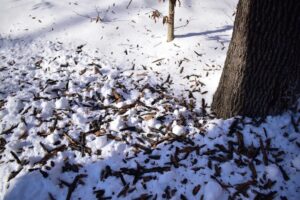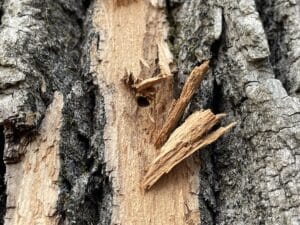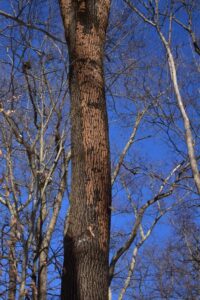Hello fellow readers, Upon investigating the culprit of a tree largely de-barked, I learned the US Department of Animal and Plant Health Inspection recently dropped the quarantine laws to prevent the further spread of Emerald Ash Borer. Could it be that EAB is a lost cause?
 After the last snowstorm, I noticed a troubling pile of bark shed from a tree along our road. It’s amazing how you see such things more clearly when snow covers the ground like a white canvas. It looked to be woodpecker damage, although the volume is astounding. The deeply creviced diamond-shaped bark is off more than half of the tree, exposing the rust-colored inner bark, called phloem.
After the last snowstorm, I noticed a troubling pile of bark shed from a tree along our road. It’s amazing how you see such things more clearly when snow covers the ground like a white canvas. It looked to be woodpecker damage, although the volume is astounding. The deeply creviced diamond-shaped bark is off more than half of the tree, exposing the rust-colored inner bark, called phloem.
They say it’s best to remove trees infested with EAB —ASAP.
I’m not the best at identifying trees when they are leafless. While attending a design colleague and friend’s outside holiday gathering, I learned the de-barked tree is an ash tree (Fraxinus) riddled with the Emerald Ash Borer. Marty’s helpers cut down two of her ash trees because once damage covers half of the tree, or half the tree canopy is thinning, it’s too late to save them.
After infestation, an ash tree will only live for three to five years. And tree experts are not likely to take them down after they die because they quickly become too brittle and too dangerous to climb.
Emerald Ash Borers do not discriminate between species.
Emerald Ash Borer (Agrilus planipenni) is an invasive wood-boring insect that kills all species of ash trees. First discovered in Michigan in 2002, EAB likely came from overseas cargo. It’s now in 35 states and three provinces of Canada.
The adult Emerald Ash Borer is a half-inch long metallic green beetle with a copper-red abdomen. The inch-long white or cream larvae feed on the phloem under the outer bark, killing trees by interrupting the flow of water and nutrients.
 EAB adults emerge in May or early June, creating D-shaped exit holes. They first infest the top of the tree’s crown, which makes the damage hard to see. Woodpecker activity can be an initial sign, but as EAB populations increase, dieback will occur.
EAB adults emerge in May or early June, creating D-shaped exit holes. They first infest the top of the tree’s crown, which makes the damage hard to see. Woodpecker activity can be an initial sign, but as EAB populations increase, dieback will occur.
Hundreds of millions of Ash Trees have been killed by EAB.
According to the NJ Department of Agriculture, there are 24.7 million ash trees in my neck of the woods, mostly in the state’s northern part. The PA Department of Conservation & Natural Resources reports 308 million ash trees located all through the state.
And, throughout North America, Ash trees are found in a quarter of all forests. They are also commonly seen in landscapes, lining streets and parks. Per the US Department of Agriculture, hundreds of millions of ash trees have been killed, costing hundreds of millions of dollars to property owners, municipalities, nurseries, and forest products industries.
Yet quarantine laws to prevent further spread have recently been lifted.
 While EAB beetles can fly a half-mile, much of the spread is through the movement of infested firewood. There were quarantine laws prohibiting firewood between counties and states to prevent further spread. But as of January 14th, the quarantines have been lifted, as reported in the US Department of Animal and Plant Health Inspection’s Federal Register (published 12/15/20).
While EAB beetles can fly a half-mile, much of the spread is through the movement of infested firewood. There were quarantine laws prohibiting firewood between counties and states to prevent further spread. But as of January 14th, the quarantines have been lifted, as reported in the US Department of Animal and Plant Health Inspection’s Federal Register (published 12/15/20).
The cliff notes version is, the federal domestic EAB quarantine regulations are no longer useful. Commenters in states west of the Rocky Mountains still believe removing the quarantine will increase infested wood’s probability of moving into their state. The comeback, “states are free to establish their regulations.”
The Emerald Ash Borer Information Network is a valuable source filled with up-to-date information broken down by state. The good news is their January 4th report indicates “no initial county detections to report for December,” adding a smiley face. A happy update indeed.
How to save specimen Ash Trees
Emerald Ash Borer is not necessary a lost cause. For trees worthy of being saved – such as lawn specimens not yet infected or only mildly so, trunk injections work best. Specifically, Emamectin benzoate, also known as Tree-age, is injected into a tree’s vascular system by an arborist. It’s expensive but effective. Yes, there are protective cover sprays that homeowners can apply. But it would be much wiser to do more than cover your ash.
Garden Dilemmas? AskMaryStone@gmail.com (and now on your favorite Podcast App.)
You’ll enjoy a column about who likely de-barked our tree titled Mischievous Pileated Woodpecker and a follow-up on this story titled Help Control Emerald Ash Borer Spread
Helpful Links:
Emerald Ash Borer Information Network (EmeraldAshBorer.info)
Link to the Federal Registrar about the Removal of Emerald Ash Borer Domestic Quarantine Regulations


